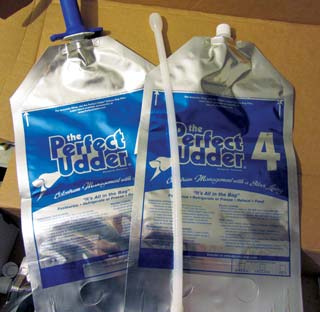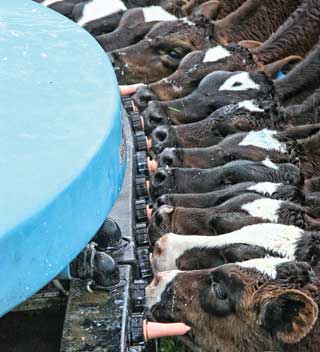4 Apr 2016
Sara Pedersen discusses spring-calving herds, and why it is vital not only the cows, but also the calves, get off to the right start.

Figure 1. Calving paddocks should be grazed for two weeks and rested for four to prevent infection from building up. Image: Phillip Minnis/Fotolia.
Just like any system, block calving in the spring has both its advantages and disadvantages, and its success is predominantly driven by how effective the management of the herd is.

In comparison to all-year-round calving herds, in block-calving herds the majority of cows will be in one of two different stages of their lactation cycle, which can make things easier and more efficient from a feeding, labour and management perspective.
Decisions and interventions can be made at a herd or group level, rather than directed at the individual cow.
Pregnancy diagnosis, synchronisation programmes, routine hoof trimming and vaccinations can all be handled as a group. More concentrated and efficient supervision of calving is also possible, particularly when additional help is sought during the calving season.
From a youngstock point of view, since all calves will be on the same rearing programme and at the same stage of growth, it makes it easier to identify those that are not thriving and either require additional attention or exclusion from the future replacement pool.
The main driver behind batch-calving spring herds in the UK is, however, the more efficient utilisation of the spring grass, so the energy requirements of the cow follow the pattern of grass growth. This maximises milk production from grass and minimises the requirement for supplementary feeding.
As with every system, there are disadvantages. Cows that fail to conceive during one mating period are either culled or carried over to the following mating period.
While it is inevitable some cows will always fail to fit into the breeding pattern, prospective planning is required to alleviate any problems that could affect fertility across the whole herd and lead to problems with maintaining calving pattern, for example, outbreaks of infectious disease and inadequate transition management.
Although calving large numbers of cows in a short period of time can create opportunities for greater attention to detail, it can also work in reverse if staff are overloaded or lack skill and experience. Therefore, careful planning is needed with sufficient training of staff where necessary.
Calves in block-calving herds need to grow well enough so that are able to enter the herd as first lactation heifers two years after birth. Therefore a disease outbreak in the calves can have a big impact on the availability of replacements a couple of years later.
Not only can heifers be lost through mortality, but the high morbidity of many calf diseases can also result in poor growth rates, and thus an extended time until heifers achieve target mating weight. Later-born calves not only have a shortened period to achieve these targets in, but they can also be up against a bigger challenge when it comes to disease. In the majority of cases, a later-born heifer will become a later-calving cow.
The calving area is a potential bottleneck in a calving herd, as adequate space must be available to calve down a large number of cows in a short space of time.
The amount of bedded area required for an individual adult cow pre-calving is based on herd yield rather than breed or size.
For every 1,000 litres of production at herd level, each cow should have 1.25m2 of lying space (excluding feeding and loafing area), so a 6,000 litre cow would require 7.5m2 and a 8,000 litre cow 10m2.
As well as keeping stocking densities at this level it is also important the bedded area is kept clean and dry.
Bacteria thrives in moist, warm conditions, increasing the risk of contamination of the teats, udder and legs, which can ultimately expose the calf to greater risk of infection.
Additional to the benefits to the calf of maintaining a clean, dry-calving yard, there are also many for the cow. Over-stocked yards will inevitably lead to competition for feed barrier space, and this can limit intakes pre-calving, leaving cows more predisposed to negative energy balance and the resultant periparturient conditions associated with it – including metritis and endometritis.
Higher stocking rates are also associated with an increased risk of mastitis in early lactation, since it is just before calving that cows are most at risk of acquiring a new intramammary infection. This doesn’t just apply to cattle calving indoors, but also to those calving in paddocks, since a build-up infection on the pasture in mild spring weather can also result in an increased risk of infection.
Rather than using a single-calving paddock, it is recommended at least three are used on a rotational basis, so they are grazed for two weeks and then rested for four, therefore decreasing the build-up of infection (Figure 1).
Although many farmers have been changing their practices, it is still relatively common to only feed calves two litres of colostrum at birth. Research conducted more than a decade ago showed the volume of colostrum fed in the first six hours of life had a significant impact on future growth rates and productivity (Faber et al, 2005).
As shown in Table 1, Brown Swiss dairy calves that received two litres of colostrum within one hour of birth on average grew at slower rates (0.8kg/day), compared to calves fed 4 litres of colostrum (1.03kg/day).
The most common cause of slower growth rates in calves is disease, in particular scour and pneumonia. The additional immunological protection a large volume of colostrum provides helps calves combat infections and invest energy in growing rather than fighting infection.
To ensure effective passive transfer, feeding calves 10% of bodyweight in colostrum within two hours of birth is recommended (approximately 4L to 5L for a Holstein calf and 3L for a Jersey). As well as the calves receiving sufficient quantity of colostrum quickly enough, the importance of colostrum quality and hygiene is also well documented, so the calf receives the full potential from it.

Bacterial numbers in colostrum can double every 20 minutes and, therefore, unless it is fed to calves within one hour of collection, it should be refrigerated, frozen or pasteurised to reduce the rate of microbe multiplication (Figure 2).
Since infectious scour is the result of ingestion of the causative agent, hygiene is an essential component of controlling it. Batch-calving herds need to plan carefully where they are going to rear calves to prevent build-up, either in the calf housing or on the pasture, leaving later-born calves at greater risk.
While colostrum helps to provide protection against scours due to Escherichia coli, Rotavirus and Coronavirus, it provides little, if any, protection against Cryptosporidium and this can prove a particular challenge to block calving herds.
Cryptosporidium is a protozoan parasite that is highly infectious, with only 10 oocysts capable of infecting a calf. The oocysts can survive for up to six months in a moist environment and are not killed by most of the commonly used disinfectants at the recommended concentrations.
Therefore, while batch calving can prevent carry over of disease from year to year, the nature of the infection and the potential for environmental contamination to rapidly escalate can make it hard to control.
The calving yard or paddock can be a source of infection to newly born calves, as cows can shed the oocysts in faeces. This can lead to newly born calves becoming infected and potentially shedding billions of oocysts into the environment after the three-day pre-patent ends. Therefore, management of the calving yard and paddocks is critical to preventing over-stocking and the build-up of infection pressure.
As well as the faecal-oral route of transmission, indirect spread through fomites, such as contaminated feed buckets and equipment, is possible. Steam cleaning of equipment is pivotal in preventing spread (Figure 3). Since watercourses are also a potential source of contamination, this should also be a consideration when calves are turned out to grass pre-weaning.
Alongside scour, pneumonia is one of the most common diseases affecting the growth rates of calves, and outbreaks in groups in batch-calving herds can have a large knock-on effect on future replacement availability.

Mixing of age groups is a big risk factor for pneumonia and rearing groups should be limited to an age range of two weeks, with a maximum of 40 calves in each group. In batch-calving herds of sufficient size it is more achievable to manage calves within groups of this age range and alleviate the risk of older calves spreading infection to the younger calves.
However, it is important “poor doing” calves are not moved down from one age group to the next and that a true batch-rearing system is followed.
As with scour, colostrum management is an important component of pneumonia control, along with hygiene. Since many bacteria and viruses involved in pneumonia are found in the saliva, shared feeding equipment is a potential way disease
is spread.
Therefore, ensuring feeding equipment is only used for specific batches of calves and that it is cleaned after every feed to reduce the risk of biofilm formation is an important part of disease control.
Cleaning and disinfection of equipment should be carried out away from the calves, since bacteria cannot travel without moisture.
As moisture in the air provides bacteria with a vehicle they can spread on, humidity and ventilation are important factors in reducing pneumonia risk. Calves do not produce as much body heat as adult cattle and therefore cannot ventilate buildings through the stack effect alone.
In poorly ventilating buildings, a number of options are available to ensure calves receive a continual supply of fresh, still air, including the installation of fans and positive pressure tube ventilation systems.
Spring block-calving herds can only be successful if both the cow and her calf get off to the very best start. Any challenge the calf or cow face can have detrimental effects on a herd’s productivity in both the short and the long term.
Each year, it is important the performance of the previous calving season is reviewed, and bottlenecks are identified, so improvements can be focused. Calf management and prevention strategies are critical as it can be difficult to break the cycle and regain lost time once scour and pneumonia outbreaks occur.